These NCERT Solutions for Class 7 Science Chapter 3 Fibre to Fabric Questions and Answers are prepared by our highly skilled subject experts to help students while preparing for their exams.
Fibre to Fabric NCERT Solutions for Class 7 Science Chapter 3
Class 7 Science Chapter 3 Fibre to Fabric Textbook Exercise Questions and Answers
Question 1.
You must be familiar with the following nursery rhymes:
i. ‘Baa baa black sheep, have you any wool.’
ii. ‘Marry had a little lamb, whose fleece was white as snow’.
Answer the following:
a. Which parts of the black sheep have wool?
b. What is meant by the white fleece of the lamb?
Answer:
a. The fleece (hair) of the black sheep has wool.
b. White fleece of the lamb means the white coloured hair on the skin of the sheep.
Question 2.
The silkworm is: (i) a caterpillar, (ii) a larva.
Choose the correct option:
a. (i)
b. (ii)
c. Both (i) and (ii)
d. Neither (i) nor (ii)
Answer:
c. Both (i) and (ii)
Question 3.
Which of the following does not yield wool?
a. Yak
b. Camel
c. Goat
d. Woolly dog
Answer:
d. Woolly dog
Question 4.
What is meant by the following terms?
a. Rearing
b. Shearing
c. Sericulture
Answer:
a. Rearing: The process of keeping, feeding, breeding and taking medical care of useful animals is called rearing of animals. These animals produce one or more useful products for human use.
b. Shearing: The fleece (hair) of sheep is shaved off along with the thin layer of skin. This is similar to shaving beards or hair and this process is called shearing.
c. Sericulture: The rearing of silkworms for obtaining silk is called sericulture.
![]()
Question 5.
Given below is a sequence of steps in the processing of wool. Which are the missing steps? Add them.
Shearing, …………., sorting, …………., …………., ………….
Answer:
Shearing, Scouring, sorting, removing burrs, dying and rolling into yarns.
Question 6.
Make sketches of the stages in the life history of the silk moth which are directly related to the production of silk.
Answer:
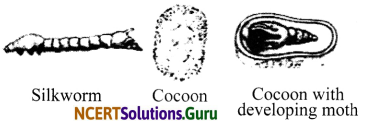
Question 7.
Out of the following, which are the two terms related to silk production? Sericulture, Floriculture, Moriculture, Apiculture and Silviculture.
Hints:
a. Silk production involves cultivation of mulberry leaves and rearing silkworms.
b. Scientific name of mulberry is Morus alba.
Answer:
a. Sericulture
b. Moriculture.
Question 8.
Match the words of column I with those given in column II.
| Column I | Column II |
| 1. Scouring | (a) Yields silk fibres |
| 2. Mulberry leaves | (b) Wool yielding animal |
| 3. Yak | (c) Food of silkworm |
| 4. Cocoon | (d) Reeling |
| (e) Cleaning sheared skin |
Answer:
1. (e)
2. (c)
3. (b)
4. (a)
Question 9.
Given below is a crossword puzzle based on this lesson. Use hints to fill in the blank spaces with letters that complete the words.
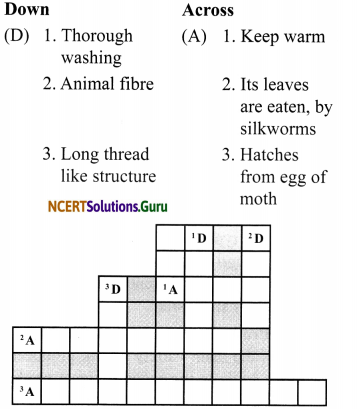
Answer:
1D. Scour 1A. Wool
2D. Silk 2A. Mulberry
3D. Fibre 3A. Caterpillar
![]()
NCERT Extended Learning Activities and Projects
Question 1.
Paheli wants to know the maximum length of continuous silk thread that can be obtained from a cocoon. Find out for her.
Hint:
The maximum length of continuous silk that can be obtained from a cocoon is approximately 900 metres.
Question 2.
Boojho wants to know why caterpillars need to shed their skin when they grow bigger but we humans do not. Do you have any idea?
Hint:
The skin of caterpillars does not grow. As their body grows, they have to move out of their skin because it becomes too tight for them. However, humans’ skin also grows with their body and hence is not required to shed.
Question 3.
Boojho wants to know why caterpillars should not be collected with bare hands. Can you help him?
Hint:
Caterpillars are toxic and can cause allergy when touched with bare hands.
Question 4.
Paheli wanted to buy a silk frock and went to the market with her mother. There they found that the artificial (synthetic) silk was much cheaper and wanted to know why. Do you know why? Find out.
Hint:
Artificial silk or rayon is produced in mills in bulk at one time and requires less labour and skill whereas original silk is produced by the silkworms and it requires a lot of skill, labour and time to treat the worms and extract silk from them. Hence artificial silk is cheaper than natural silk.
![]()
Question 5.
Someone told Paheli that an animal called ‘Vicuna’ also gives wool. Can you tell her where this animal is found? Look for this in a dictionary or an encyclopaedia.
Hint:
Vicuna are native to the central Andes in South America. They are found in Peru, north-western Argentina, Bolivia, and northern Chile.
Question 6.
When handloom and textile exhibitions are held, certain stalls display real moths of various varieties of silk and their life histories. Try and visit these stalls with elders or teachers and see these moths and stages of their life history.
Hint:
Do yourself.
Question 7.
Look for eggs of any moth or butterfly in your garden or park or any other place full of plants. They look like tiny specks (dots) laid in a cluster on the leaves. Pull out the leaves containing eggs and place them in a cardboard box. Take some leaves of the same plant or another plant of the same variety, chop them and put them in the box. Eggs will hatch into caterpillars, which are busy eating day and night. Add leaves every day for them to feed upon. Sometimes you may be able to collect the caterpillars. But be careful. Use a paper napkin or a paper to hold a caterpillar. Observe everyday. Note the.
a. number of days taken for eggs to hatch,
b. number of days taken to reach the cocoon stage,
c. number of days to complete life cycle.
Hint:
a. The hatching period varies from insect to insect. For example: in houseflies, the eggs hatch out within 10 to 15 hours of copulation.
Eggs of the moth or caterpillars hatch in 2-3 weeks.
b. In common mulberry silk moth, the caterpillar completely transforms into pupa within 12 to 15 days.
c. It depends upon the insect moth or
![]()
Activity 1
Objective: To study the burning of different fibres used for making cloth.
Materials Required: One fibre each of wool, silk, rayon and nylon, forceps, candle and a
matchbox.
Procedure:
- Light a candle. Hold a woollen fibre with forceps and bum it in the candle flame.
- Smell the vapours while burning by wafting carefully.
- Similarly bum fibres of silk, rayon and nylon one by one and then smell their vapours by wafting.
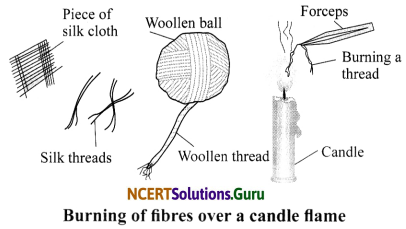
Observation: Fibres like silk and wool bum slowly and shrinks or curls away from the flame. On the other hand, fibres like rayon and nylon ignite and bum quickly and can continue to bum after the flame is removed.
Conclusion: Wool and silk are natural fibres. Very little smoke is produced on their burning but it smells like burnt hair (wool) or feathers (silk). Rayon and nylon are synthetic fibres.’ Burning these fibres produces black smoke and hazardous fumes.
Wool: Wool bearing animals have a thick coat of hair on their skin to help them trap a lot of air which keeps these animals warm. The skin of a sheep has two types of fibres:
i. coarse beard hair, and
ii. fine soft under-hair close to the skin. The fine soft hair fibres are used for making wool.
Selective Breeding: The process of selecting parents for obtaining special characters, such as fine soft under-hair in sheep, is termed as selective breeding.
Rearing and Breeding of Sheep: Sheep are herbivorous and prefer to eat grass and leaves. Shepherds in different parts of our country take their herds of sheep for grazing. Apart from this, rearers also feed them on a mixture of pulses, com, jowar, oil cakes and minerals. In winters, they are kept indoors and fed on leaves, grains and dry fodder. Once they develop a thick growth of hair, the hair is shaved off for getting wool.
Several breeds of sheep are found in different parts of our country. Some Indian breeds of sheep which provide wool are given in the table below.
| S. No. | Name of Breed | Quality of wool | State where found |
| 1. | Lohi | Good quality wool | Rajasthan, Punjab |
| 2. | Rampur bushair | Brown fleece | Uttar Pradesh, Himachal Pradesh |
| 3. | Nali | Carpet wool | Rajasthan, Haryana, Punjab |
| 4. | Bakharwal | For woollens shawls | Jammu and Kashmir |
| 5. | Marwari | Coarse wool | Gujarat |
| 6. | Patanwadi | For hosiery | Gujarat |
Apart from the fleece of sheep, there are other sources of wool as well. Animals that provide wool are described below.
- Yak is reared in Tibet and Ladakh.
- Angora goats are reared in hilly regions such as Jammu and Kashmir. They provide Angora wool and Mohair.
- The under-fur of Kashmiri goat is very soft and is woven into fine shawls known as Pashmina shawls.
- Camels are reared in Rajasthan. The hair of camel can be woven into light¬weight and durable fabric.
- Alpaca are found in the Andes Mountains of South America. They are domesticated by the natives of Peru to get their soft wool. The woolly hair varies in colour from white to red to dark brown to black.
- Llama is found in mountains of South America. The male is used as a beast of burden. The female is highly valued for her milk, meat, hide and wool.
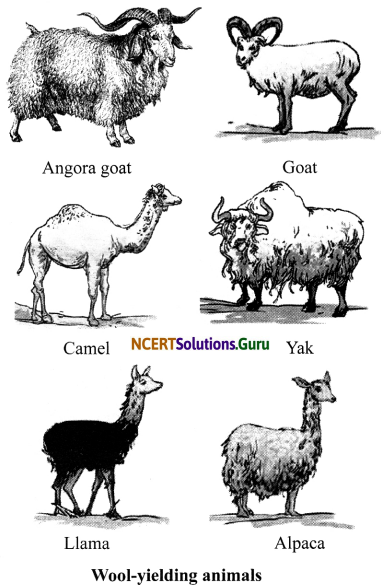
Processing of Fleece into Woollen Fabric:
- The fleece (hair) of sheep is shaved off along with the thin layer of skin. This is similar to removing beards or hair. This process is called shearing. It is done in hot weather to enable sheep to survive without hair coat. Since the uppermost layer of skin is dead, shearing does not hurt the animal and hair grow again after some time.
- After shearing, the fleece is washed properly to remove dirt and grease. This washing of fleece after shearing is called scouring. This is done in tanks or by machines.
- Clean hairy skin is sent to the factory where the hair of different textures are sorted (separated). This is called sorting.
- The small fluffy fibres, called burrs, are picked out from the hair. The fibres are scoured again and dried.
- After sorting and picking out of burrs, the fibres are dyed in desired colours.
- The fibres are then straightened, combed and rolled into yams. Wool yam is used in knitting sweaters and woollen cloths, i.e., fabric.
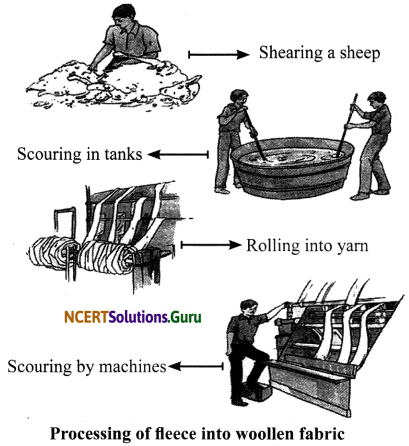
The risks faced by the workers in any industry are called occupational hazards. One such hazard is the bacterial disease anthrax. It is caused by a bacterium that lives on the skin of sheep and causes severe fatal blood disease in the workers of wool industry. It is also called sorter’s disease.
Silk: It is another important animal fibre. We get silk from silkworms. Silk fibre is obtained from the cocoons of the silk moth. The silk moth lives on the leaves of mulberry plants. The mulberry silk fibre is soft, lustrous and elastic and can be dyed in beautiful colours. The rearing of silk moth for obtaining silk is called sericulture.
Life Cycle of Silk Moth: There are four stages in the life cycle of a silk moth: egg, larva, pupa and adult.
The life history of a silk moth starts when a female silk moth lays eggs on mulberry leaves. This procedure happens once every year. The larvae or caterpillars hatch from the eggs of the silk moth. These caterpillars or silkworms feed on fresh mulberry leaves. After 25-30 days, the caterpillars grow in size and then become pupa.
In the pupa stage, it weaves a net to hold itself. It then swings its head from side to side, secreting proteinaceous fibres that hardens on coming in contact with air. The caterpillars cover itself completely with silk fibre and turns into a pupa. This covering is known as the cocoon. The moth continues to develop within the cocoon. The silk thread or yam is obtained from the cocoon of the silk moth.
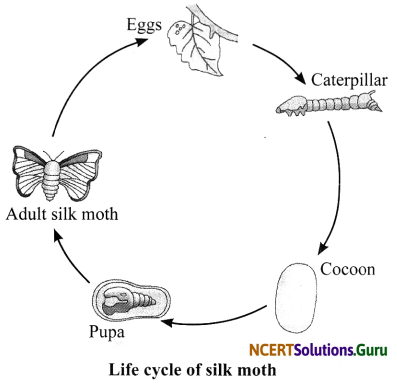
Rearing of Silkworms: For obtaining silk for silk industry, silk moths are reared and their cocoons are collected to get silk thread. In the beginning, the female silk moth lays hundreds of eggs. These eggs are stored over a clean paper or a piece of cloth. These eggs are then sold to the silkworm farmers. The farmers keep the eggs under accurate temperature and humidity at a clean place. Bamboo trays are used to keep these caterpillars and some freshly chopped mulberry leaves are kept in the tray. The caterpillars eat these mulberry leaves day and night and grow in size. After 25-30 days approximately, the caterpillars stop eating the leaves and then move inside the small chambers in the bamboo trays to spin cocoons.
Processing of Silk: The cocoons are used to obtain silk threads. When the cocoons are exposed to the sun or steam or are boiled, the silk fibre gets separated. This process of getting silk threads from the cocoons to use it as silk is known as reeling of the silk. Reeling of the silk is carried out by special machines. These machines unwind the fibres of silk or threads from the cocoon. Silk fibres are then converted into silk threads to make different kinds of silk fabrics.
There is a variety of silk moths which yield different types of silk yarn such as Tassar silk, Mooga silk, Kosa silk. Mulberry silk, etc. They yield different varieties of coarse, smooth or shiny silk.
Silk Producing States of India: Mulberry silk is the main variety of silk produced in India. India is the second largest producer of silk in the world after China. About 90% of the mulberry silk comes from Karnataka, Andhra Pradesh and Tamil Nadu. States like Assam, Madhya Pradesh and Orissa also produce silk.
Discovery of Silk: Silk was discovered in China when the empress Si-Lung-Chi was asked by the emperor Hung-ti to find the cause of damaged leaves of mulberry. The empress found white worms eating those leaves and spinning shiny cocoons. A cocoon fell into her cup of tea and a tangle of delicate threads separated out from the cocoon. Silk industry was hence born and was later introduced to other countries.
Class 7 Science Chapter 3 Fibre to Fabric Additional Important Questions and Answers
Very Short Answer Type Questions
Question 1.
What are fibres?
Answer:
The thin strands of a thread are called fibres.
Question 2.
Name two animals which provide wool.
Answer:
Sheep and yak.
![]()
Question 3.
What are the sources of wool and silk?
Answer:
Animals are the sources of wool and silk.
Question 4.
From which animal is silk obtained?
Answer:
Silk Moth.
Question 5.
Where is the yak wool common in India?
Answer:
Ladakh.
Question 6.
What are burrs?
Answer:
The small fluffy fibres in wool are called burrs.
Question 7.
What is cocoon?
Answer:
A cocoon is a covering of silky threads that the larvae of the silk moth make for themselves before they grow into adults.
Question 8.
Where is Alpaca found?
Answer:
Alpaca is found in the Andes mountain of South America.
Question 9.
Where is the Lohi breed of sheep found in India?
Answer:
Lohi breed is found in Gujarat.
Question 10.
What is the most common type silk?
Answer:
Mulberry silk.
![]()
Question 11.
In which stage does the silk moth spin the silk fibre around itself?
Answer:
Caterpillar stage.
Question 12.
What is the food of silk moth?
Answer:
Mulberry leaves.
Question 13.
Which stage comes earlier in the life history of a silk moth: pupa or larva?
Answer:
Larva.
Question 14.
State whether the artificial silk is an animal fibre or a plant fibre?
Answer:
Plant fibre.
Question 15.
Which part of the animals is used to get wool?
Answer:
Wool is obtained from the fleece or hair.
![]()
Question 16.
What do Angora goats provide us?
Answer:
Angora wool.
Question 17.
How much time does a caterpillar take to turn into a mature pupa.
Answer:
3 to 4 weeks.
Question 18.
Where is cotton grown?
Answer:
Cotton is grown in fields. Cotton plants are grown at places having black soil and warm climate.
Question 19.
What is the scientific name of mulberry?
Answer:
Scientific name of mulberry is Morus alba.
Question 20.
What is sericulture?
Answer:
The rearing of silkworms for obtaining silk is called sericulture.
Short Answer Type Questions
Question 1.
What is sorting?
Answer:
Clean hairy skin sheared off animals is sent to the factory where hair of different textures are sorted (separated). This is called sorting.
Question 2.
Define reeling of silk?
Answer:
The process of taking out the silk fibres from the cocoon for use as silk is called reeling. Reeling is done in special machines which unwind the silk from cocoons.
![]()
Question 3.
Explain the process to obtain silk thread from cocoon.
Answer:
Cocoons of silk moth are used to obtain the silk fibres. These Cocoons are kept under the sun or boiled or exposed to steam. The silk fibres are thus separated out. This process of obtaining wool from the cocoons is called reeling of silk. Reeling is done in special machines.
Question 4.
What is scouring?
Answer:
Fleece, after shearing, is washed properly to remove dirt and grease. The washing of fleece, after shearing, is called scouring.
Question 5.
What do sheep feed on?
Answer:
Sheep are herbivores and prefer to eat grass and leaves. Apart from grazing sheep, rearers also feed them on a mixture of pulses, com, jowar, oil cakes (material left after taking out oil from seeds) and minerals.
Question 6.
Where is rearing and breeding of sheep popular in India?
Answer:
Rearing and breeding of sheep is popular in Jammu and Kashmir, Himachal Pradesh, Uttaranchal, Arunachal Pradesh, Sikkim and the plains of Haryana, Punjab, Rajasthan and Gujarat.
Question 7.
What are the two types of fibres that form the fleece of a sheep?
Answer:
The hairy skin of sheep has two types of fibres that form its fleece:
- the coarse beard hair, and
- the fine soft under-hair close to the skin.
Question 8.
What is selective breeding?
Answer:
Some breeds of sheep possess only fine under-hair. Their parents are specially chosen to give birth to sheep which have only soft under-hair. This process of selecting parents for obtaining special characters in their offspring, such as soft under-hair in sheep, is termed as ‘selective breeding’.
![]()
Question 9.
What is Angora wool?
Answer:
The wool which is obtained from the Angora goats is called Angora wool. The Angora goats are found in the hilly regions such as Jammu and Kashmir.
Question 10.
List a few animals in different regions that are reared for obtaining wool?
Answer:
Various kinds of animals are reared for wool:
- Yak: Yak wool is common in Tibet and Ladakh.
- Angora goats: They are used to obtain Angora wool. They are found in hilly regions.
- Kashmiri goats: They are used to obtain fur.
- Camel: It also provides fur.
- Llama and Alpaca: They are found in South America and also yield wool.
Question 11.
How are silk fibres of different textures prepared?
Answer:
The silk yam is obtained from the cocoon of the silk moth. There is a variety of silk moths which look very different from one another and the silk yam they yield is different in texture like coarse, smooth, shiny, etc. Thus, Tassar silk, Mooga silk and Kosa silk are obtained from the cocoons spun by different types of moths.
Question 12.
What happens when the silk caterpillar stops feeding?
Answer:
When the silk caterpillar stops feeding, its salivary gland starts secreting a sticky fluids (a protein called fibroin). This fluid hardness on exposure to air and forms a long thread of silk. This thread gets wrapped around its body to form a ball-like structure called cocoon.
Long Answer Type Questions
Question 1.
Explain the process of rearing of silkworms.
Answer:
An egg is laid by a female moth which is mostly the size of small dots. A female moth lays more than 350 eggs at a time in the spring. The eggs hatch due to the warmth in the air. This procedure happens once in every year. Hairy silkworms arise after the eggs crack. In this stage of silkworms, the growth happens. They feed on mulberry leaves and consume a large amount of these leaves for around 30 days before going to the next stage. Silkworms spin a protective cocoon around itself. It is of the size of a small cotton ball and is made of a single thread of silk. The cocoon is exposed to boiling water to unwind the silk thread. Then pupa changes into an adult moth. The female moth lays eggs after mating and thus the life cycle of silkworm begins again.
Question 2.
Name some breeds of sheep reared in our country. Explain the quality of wool they provide and the state where they are found.
Answer:
|
S. No. |
Name of breed | Quality of wool |
State where found |
| 1. | Bakharwal | For woollen shawls | Jammu and Kashmir |
| 2. | Marwari | Coarse wool | Gujarat |
| 3. | Lohi | Good quality wool | Rajasthan, Punjab |
| 4. | Nali | Carpet wool | Rajasthan, Haryana, Punjab |
| 5. | Patanwadi | For hosiery | Gujarat |
| 6. | Rampur Bushair | Brown fleece | Uttar Pradesh, Himachal Pradesh |
![]()
Question 3.
Explain the various steps involved in the process of making wool?
Answer:
The steps involved in wool production are as follows:
- The fleece (hair) of sheep is shaved off along with the thin layer of skin. This is similar to shaving beards or hair and this process is called shearing.
- Fleece, after shearing, is washed properly to remove dirt and grease. The washing of fleece, after shearing, is called scouring.
- Clean hairy skin is sent to the factory where hair of different textures is sorted (separated). This is called sorting.
- The small fluffy fibres, called burrs, are picked out from the hair. Fibres are again scoured and dried.
- After sorting and picking out of burrs, the fibres are dyed in desired colours.
- The fibres are then straightened, combed and rolled into yarns. Wool yam is used in knitting sweaters and woollen cloths, i.e., fabric.
Question 4.
What do you know about the discovery of silk?
Answer:
According to an old Chinese legend, the empress Si-lung-Chi was asked by the emperor Huang-ti to find the cause of the damaged leaves of mulberry trees growing in their garden. The empress found white worms eating mulberry leaves and spinning shiny cocoons around them. Accidentally, a cocoon dropped into her cup of tea and a tangle of delicate threads separated out from the cocoon. In this way, silk industry began in China and was kept a closely guarded secret for hundreds of years.
Question 5.
Explain the process of obtaining silk from cocoon.
Answer:
A pile of cocoons is used for obtaining silk fibres. The cocoons are kept under the sun or boiled or exposed to steam. The silk fibres separate out. This process of taking out threads from the cocoon for use as silk is called reeling the silk. Reeling is done in special machines, which unwind the threads or fibres of silk from the cocoon. Silk fibres are then spun into silk threads which are woven into silk cloth by weavers.
Picture-Based Questions
Question 1.
Draw a labelled diagram to show the life cycle of a silk moth.
Answer:
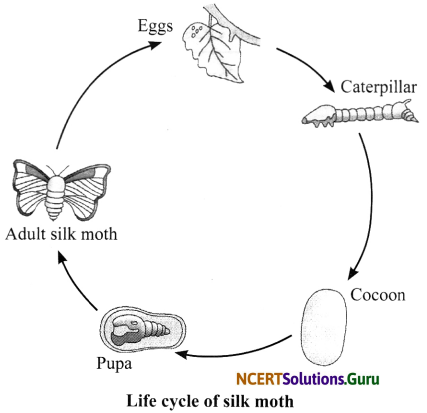
Question 2.
Identify the following animals and name the region where they are found.
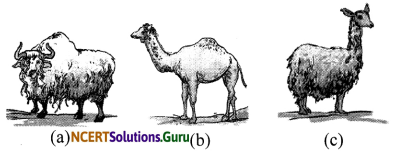
Answer:
(a) Yak, found in Tibet and Ladakh
(b) Camel, found in Rajasthan.
(c) Alpaca, found in South America